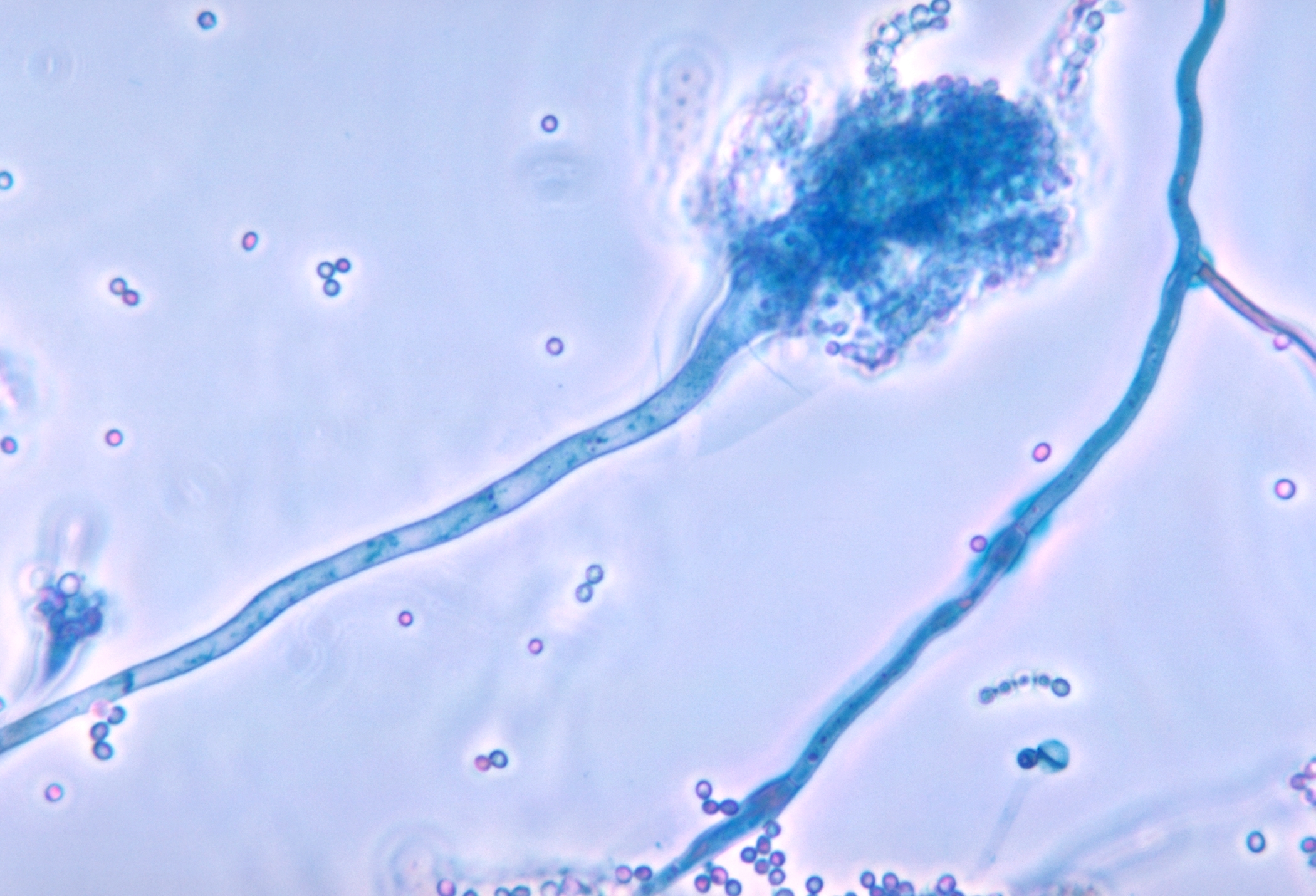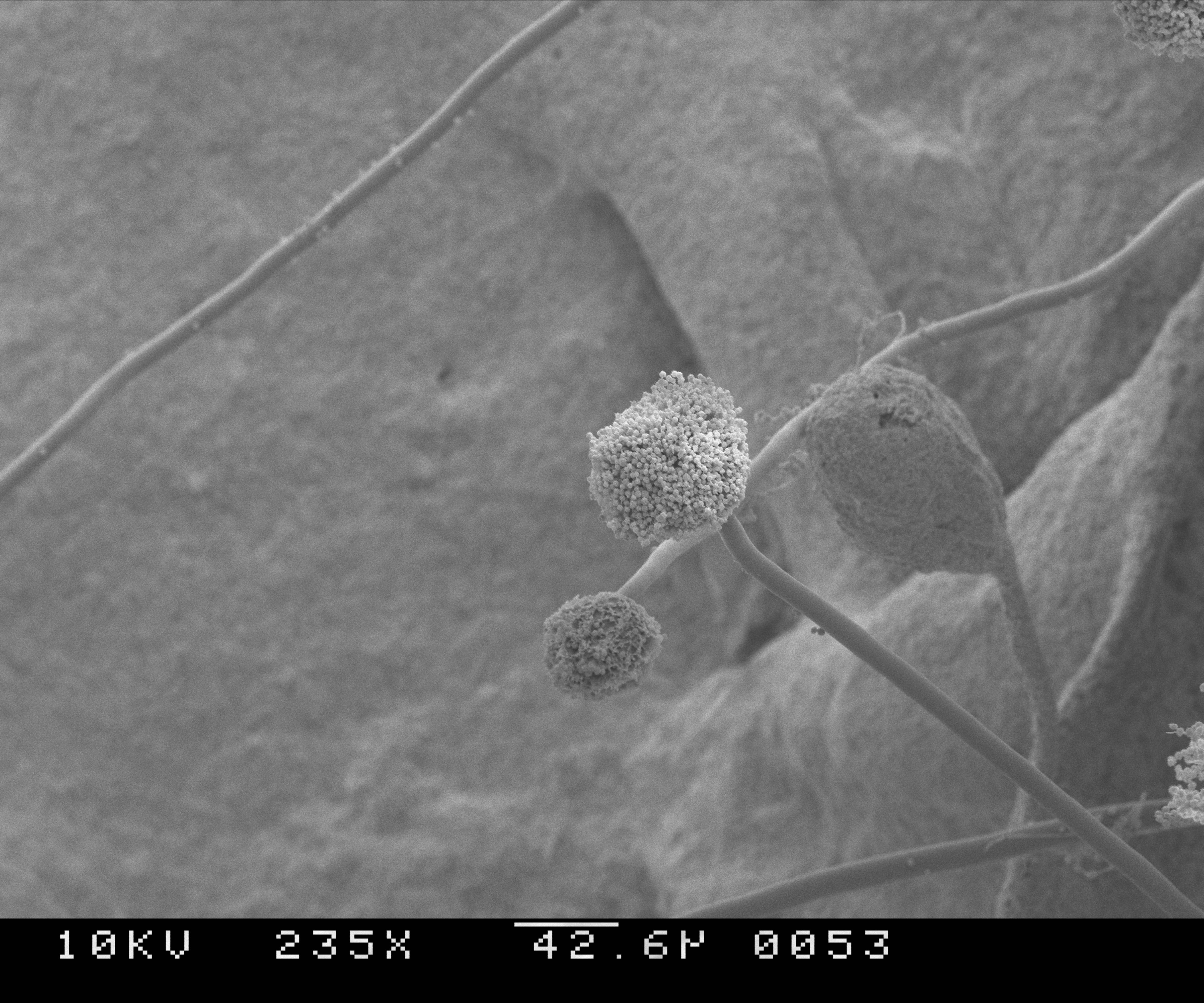|
Aspergilloma
An aspergilloma is a clump of mold which exists in a body cavity such as a paranasal sinus or an organ such as the lung. By definition, it is caused by fungi of the genus ''Aspergillus''. Signs and symptoms People with aspergillomata typically remain asymptomatic until the condition is fairly advanced; in some cases even for decades. Diagnosis is often made as a result of an incidental finding on a chest X-ray or CT scan that may be performed as part of the workup for another unrelated condition. However, a small percentage of aspergillomata invade into a blood vessel which can result in bleeding. Thus, the most common symptom of associated with aspergillomata is coughing up blood (hemoptysis). This may result in life-threatening hemorrhage, though the amount of blood lost is usually inconsequential. Aspergillomata can also form in other organs. They can form abscesses in solid organs such as the brain or kidney, usually in people who are immunocompromised. They can also develop ... [...More Info...] [...Related Items...] OR: [Wikipedia] [Google] [Baidu] |
Chronic Pulmonary Aspergillosis
Chronic pulmonary aspergillosis is a long-term fungal infection caused by members of the genus ''Aspergillus''—most commonly ''Aspergillus'' ''fumigatus''. The term describes several disease presentations with considerable overlap, ranging from an aspergilloma—a clump of ''Aspergillus'' mold in the lungs—through to a subacute, invasive form known as chronic necrotizing pulmonary aspergillosis which affects people whose immune system is weakened. Many people affected by chronic pulmonary aspergillosis have an underlying lung disease, most commonly tuberculosis, allergic bronchopulmonary aspergillosis, asthma, or lung cancer. Classification Chronic pulmonary aspergillosis as a term encompasses a number of different presentations of varying severity. There is considerable overlap between disease forms which adds to confusion during diagnosis. The primary differentiation comes from radiological findings and serology. Aspergilloma An aspergilloma is a fungus ball compos ... [...More Info...] [...Related Items...] OR: [Wikipedia] [Google] [Baidu] |
Cavitary Pneumonia
A lung cavity or pulmonary cavity is an abnormal, thick-walled, air-filled space within the lung. Cavities in the lung can be caused by infections, cancer, autoimmune conditions, trauma, congenital defects, or pulmonary embolism. The most common cause of a single lung cavity is lung cancer. Bacterial, mycobacterial, and fungal infections are common causes of lung cavities. Globally, tuberculosis is likely the most common infectious cause of lung cavities. Less commonly, parasitic infections can cause cavities. Viral infections almost never cause cavities. The terms ''cavity'' and ''cyst'' are frequently used interchangeably; however, a ''cavity'' is thick walled (at least 5 mm), while a ''cyst'' is thin walled (4 mm or less). The distinction is important because cystic lesions are unlikely to be cancer, while cavitary lesions are often caused by cancer. Diagnosis of a lung cavity is made with a chest X-ray or CT scan of the chest, which helps to exclude mimics like lung cysts, e ... [...More Info...] [...Related Items...] OR: [Wikipedia] [Google] [Baidu] |
Human Lung
The lungs are the primary organs of the respiratory system in many animals, including humans. In mammals and most other tetrapods, two lungs are located near the backbone on either side of the heart. Their function in the respiratory system is to extract oxygen from the atmosphere and transfer it into the bloodstream, and to release carbon dioxide from the bloodstream into the atmosphere, in a process of gas exchange. Respiration is driven by different muscular systems in different species. Mammals, reptiles and birds use their musculoskeletal systems to support and foster breathing. In early tetrapods, air was driven into the lungs by the pharyngeal muscles via buccal pumping, a mechanism still seen in amphibians. In humans, the primary muscle that drives breathing is the diaphragm. The lungs also provide airflow that makes vocalisation including speech possible. Humans have two lungs, a right lung and a left lung. They are situated within the thoracic cavity of the ch ... [...More Info...] [...Related Items...] OR: [Wikipedia] [Google] [Baidu] |
Aspergillus Fumigatus
''Aspergillus fumigatus'' is a species of fungus in the genus ''Aspergillus'', and is one of the most common ''Aspergillus'' species to cause disease in individuals with an immunodeficiency. ''Aspergillus fumigatus'', a saprotroph widespread in nature, is typically found in soil and decaying organic matter, such as compost heaps, where it plays an essential role in carbon and nitrogen recycling. Colonies of the fungus produce from conidiophores; thousands of minute grey-green conidia (2–3 μm) which readily become airborne. For many years, ''A. fumigatus'' was thought to only reproduce asexually, as neither mating nor meiosis had ever been observed. In 2008, ''A. fumigatus'' was shown to possess a fully functional sexual reproductive cycle, 145 years after its original description by Fresenius. Although ''A. fumigatus'' occurs in areas with widely different climates and environments, it displays low genetic variation and a lack of population genetic differentiation on a global s ... [...More Info...] [...Related Items...] OR: [Wikipedia] [Google] [Baidu] |
Aspergillus
'''' () is a genus consisting of several hundred mold species found in various climates worldwide. ''Aspergillus'' was first catalogued in 1729 by the Italian priest and biologist Pier Antonio Micheli. Viewing the fungi under a microscope, Micheli was reminded of the shape of an '' aspergillum'' (holy water sprinkler), from Latin ''spargere'' (to sprinkle), and named the genus accordingly. Aspergillum is an asexual spore-forming structure common to all ''Aspergillus'' species; around one-third of species are also known to have a sexual stage. While some species of ''Aspergillus'' are known to cause fungal infections, others are of commercial importance. Taxonomy Species In March 2010, ''Aspergillus'' covered 837 species of fungi. Notable species placed in Aspergillus include: * '' Aspergillus flavus'' is a notable plant pathogen impacting crop yields and a common cause of aspergillosis. * '' Aspergillus fumigatus'' is the most common cause of aspergillosis in individuals ... [...More Info...] [...Related Items...] OR: [Wikipedia] [Google] [Baidu] |
Hemoptysis
Hemoptysis or haemoptysis is the discharge of blood or blood-stained sputum, mucus through the mouth coming from the bronchi, larynx, vertebrate trachea, trachea, or lungs. It does not necessarily involve coughing. In other words, it is the airway bleeding. This can occur with lung cancer, infections such as tuberculosis, bronchitis, or pneumonia, and certain cardiovascular conditions. Hemoptysis is considered massive at . In such cases, there are always severe injuries. The primary danger comes from choking, rather than bleeding, blood loss. Diagnosis * Past history, history of present illness, family history ** history of tuberculosis, bronchiectasis, chronic bronchitis, mitral stenosis, etc. ** history of cigarette smoking, occupational diseases by exposure to silica dust, etc. * Blood ** duration, frequency, amount ** Amounts of blood: large amounts of blood, or there is blood-streaked sputum ** Probable source of bleeding: Is the blood coughed up, or vomited? * Bloody sput ... [...More Info...] [...Related Items...] OR: [Wikipedia] [Google] [Baidu] |
Sarcoidosis
Sarcoidosis (; also known as Besnier–Boeck–Schaumann disease) is a disease involving abnormal collections of White blood cell, inflammatory cells that form lumps known as granulomata. The disease usually begins in the lungs, skin, or lymph nodes. Less commonly affected are the eyes, liver, heart, and Human brain, brain, though any Organ (anatomy), organ can be affected. The signs and symptoms depend on the organ involved. Often, no symptoms or only mild symptoms are seen. When it affects the lungs, wheezing, coughing, shortness of breath, or chest pain may occur. Some may have Löfgren syndrome with fever, Bilateral hilar lymphadenopathy, enlarged hilar lymph nodes, arthritis, and a rash known as erythema nodosum. The cause of sarcoidosis is unknown. Some believe it may be due to an immune reaction to a trigger such as an infection or chemicals in those who are genetically predisposed. Those with affected family members are at greater risk. Diagnosis is partly based on signs ... [...More Info...] [...Related Items...] OR: [Wikipedia] [Google] [Baidu] |
Bronchiectasis
Bronchiectasis is a disease in which there is permanent enlargement of parts of the bronchi, airways of the lung. Symptoms typically include a chronic cough with sputum, mucus production. Other symptoms include shortness of breath, hemoptysis, coughing up blood, and chest pain. Wheezing and nail clubbing may also occur. Those with the disease often get lung infections. Bronchiectasis may result from a number of infection, infectious and acquired causes, including measles, pneumonia, tuberculosis, immune system problems, as well as the genetic disorder cystic fibrosis. Cystic fibrosis eventually results in severe bronchiectasis in nearly all cases. The cause in 10–50% of those without cystic fibrosis is unknown. The mechanism of disease is breakdown of the airways due to an excessive inflammatory response. Involved airways (bronchi) become enlarged and thus less able to clear secretions. These secretions increase the amount of bacteria in the lungs, resulting in airway blockage ... [...More Info...] [...Related Items...] OR: [Wikipedia] [Google] [Baidu] |
Cystic Fibrosis
Cystic fibrosis (CF) is a genetic disorder inherited in an autosomal recessive manner that impairs the normal clearance of Sputum, mucus from the lungs, which facilitates the colonization and infection of the lungs by bacteria, notably ''Staphylococcus aureus''. CF is a rare genetic disorder that affects mostly the lungs, but also the pancreas, liver, kidneys, and intestine. The hallmark feature of CF is the accumulation of thick mucus in different organs. Long-term issues include Shortness of breath, difficulty breathing and coughing up mucus as a result of frequent pneumonia, lung infections. Other signs and symptoms may include Sinusitis, sinus infections, failure to thrive, poor growth, Steatorrhea, fatty stool, Nail clubbing, clubbing of the fingers and toes, and infertility in most males. Different people may have different degrees of symptoms. Cystic fibrosis is inherited in an autosomal recessive manner. It is caused by the presence of mutations in both copies (alleles) ... [...More Info...] [...Related Items...] OR: [Wikipedia] [Google] [Baidu] |
Infectious Disease (medical Speciality)
Infectious diseases (ID), also known as infectiology, is a medical specialty dealing with the diagnosis and treatment of infections. An infectious diseases specialist's practice consists of managing nosocomial ( healthcare-acquired) infections or community-acquired infections. An ID specialist investigates and determines the cause of a disease (bacteria, virus, parasite, fungus or prions). Once the cause is known, an ID specialist can then run various tests to determine the best drug to treat the disease. While infectious diseases have always been around, the infectious disease specialty did not exist until the late 1900s after scientists and physicians in the 19th century paved the way with research on the sources of infectious disease and the development of vaccines. Scope Infectious diseases specialists typically serve as consultants to other physicians in cases of complex infections, and often manage patients with HIV/AIDS and other forms of immunodeficiency. Although many co ... [...More Info...] [...Related Items...] OR: [Wikipedia] [Google] [Baidu] |
Immunodeficiency
Immunodeficiency, also known as immunocompromise, is a state in which the immune system's ability to fight infectious diseases and cancer is compromised or entirely absent. Most cases are acquired ("secondary") due to extrinsic factors that affect the patient's immune system. Examples of these extrinsic factors include HIV infection and environmental factors, such as nutrition. Immunocompromisation may also be due to genetic diseases/flaws such as SCID. In clinical settings, immunosuppression by some drugs, such as steroids, can either be an adverse effect or the intended purpose of the treatment. Examples of such use is in organ transplant surgery as an anti- rejection measure and in patients with an overactive immune system, as in autoimmune diseases. Some people are born with intrinsic defects in their immune system, or primary immunodeficiency. A person who has an immunodeficiency of any kind is said to be immunocompromised. An immunocompromised individual may par ... [...More Info...] [...Related Items...] OR: [Wikipedia] [Google] [Baidu] |







